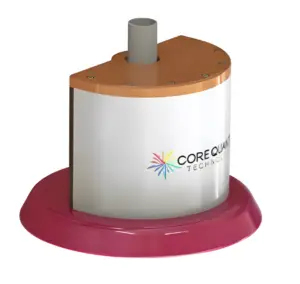Unlocking Cell Separation Potential: The CoreMag2T
In the ever-evolving field of life sciences, the pursuit of innovative tools to uncover cellular interactions is relentless. Magnetic Quantum Dots (MagDots) mark a significant advancement in this endeavor, combining fluorescence and magnetism. By collaborating with Dexter Magnetic Technologies, Core Quantum has capitalized on MagDots’ potential with the CoreMag2T Magnet, transforming cell separation methodologies.
The Power of MagDots
MagDots are a fusion of quantum dots and superparamagnetic iron oxide particles, embodying versatility for both magnetic cell separation and fluorescence-based analysis. By encapsulating these components within a single nanoparticle, MagDots enables seamless transitions between magnetic enrichment and downstream fluorescence applications like flow cytometry.
The formulation of MagDots has been meticulously optimized to align with industry demands. Through a liquid-in-liquid electrospray process, MagDots are crafted with precision, ensuring uniform size distribution and stable colloidal properties. This meticulous formulation enhances key features desired in cell sorting techniques, including high throughput, large sample processing capacity, purity, cell recovery, gentle separation, ease of implementation, and cost-effectiveness.
Dexter’s Magnet Design: Enhancing Efficiency
The collaboration between Dexter Magnetic Technologies and Core Quantum culminated in the development of the CoreMag2T Magnet, tailored to unleash the full potential of MagDot-labeled cells. Unlike conventional magnetic separation systems, the CoreMag2T Magnet embraces an “open” design, eliminating packed beads to mitigate clogging issues, particularly in heterogeneous and viscous samples.
The CoreMag2T Magnet boasts a semi-circle design, offering visual access to users and minimizing disturbance to magnetically collected cells. With a magnetic field strength approaching 2 Tesla, this magnet ensures rapid and effective separation of MagDot-labeled cell suspensions within 15 to 20 minutes, surpassing industry standards.
Practical Application: Cell Separation Protocol
To illustrate the efficacy of the CoreMag2T Magnet, let’s consider a practical scenario involving the separation of MagDot-labeled cells expressing the CD4 antigen:
- Preparation: Resuspend CytoComp cells in PBS buffer and wash them to remove serum. Incubate cells with biotinylated anti-human CD4 antibody.
- Labeling: After incubation, wash the cells and incubate them with streptavidin-conjugated 610nm MagDots.
- Magnetic Separation: Place the labeled cells in the CoreMag2T Magnet for 20 minutes. Aspirate unbound cells, and analyze the magnetic fraction using flow cytometry.
- Results: Achieve exceptional cell recovery (97%) with a purity of nearly 90%, demonstrating the efficacy of the CoreMag2T Magnet in isolating CD4-positive cells.
Emerging Applications and Future Prospects
Beyond CD4 cell separation, the CoreMag2T Magnet holds promise across diverse life science applications, from isolating rare cell populations to studying cellular dynamics in real time. Its adaptability and efficiency pave the way for advancements in cell-based therapies, diagnostics, and fundamental research.
The collaboration between Dexter Magnetic Technologies and Core Quantum has unlocked a new era in cell separation technology. With the CoreMag2T Magnet, researchers can harness the full potential of MagDots, achieving high-throughput, gentle, and efficient cell separation with unprecedented ease. As life science endeavors continue to evolve, the CoreMag2T Magnet stands as a beacon of innovation, driving progress in cellular analysis and manipulation. For a deeper understanding of this groundbreaking technology, we invite you to explore our white paper titled, CoreMag2T.


